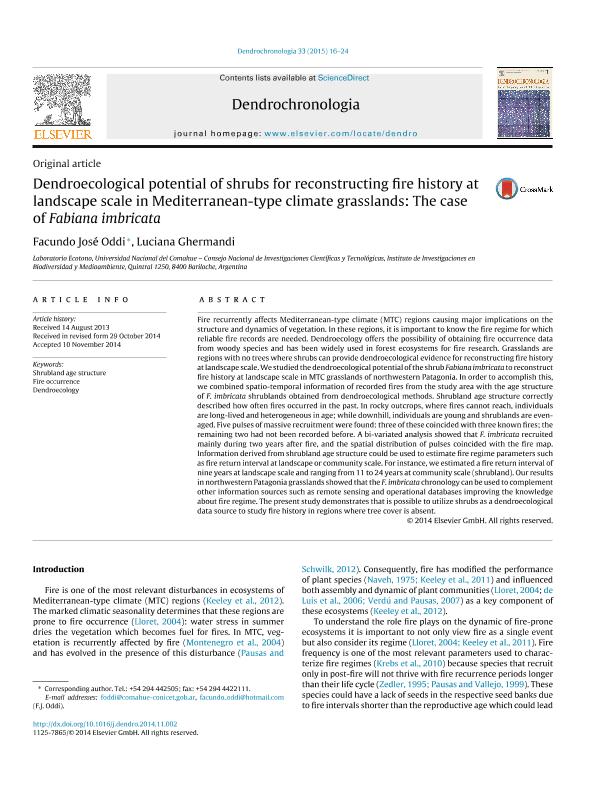Artículo
Dendroecological potential of shrubs for reconstructing fire history at landscape scale in Mediterranean-type climate grasslands: the case of Fabiana imbricata
Fecha de publicación:
01/2015
Editorial:
Elsevier Gmbh
Revista:
Dendrochronologia
ISSN:
1125-7865
Idioma:
Inglés
Tipo de recurso:
Artículo publicado
Clasificación temática:
Resumen
Fire recurrently affects Mediterranean-type climate (MTC) regions causing major implications on the structure and dynamics of vegetation. In these regions, it is important to know the fire regime for which reliable fire records are needed. Dendroecology offers the possibility of obtaining fire occurrence data from woody species and has been widely used in forest ecosystems for fire research. Grasslands are regions with no trees where shrubs can provide dendroecological evidence for reconstructing fire history at landscape scale. We studied the dendroecological potential of the shrub F. imbricata to reconstruct fire history at landscape scale in MTC grasslands of northwestern Patagonia. In order to accomplish this, we combined spatio-temporal information of recorded fires from the study area with the age structure of F. imbricata shrublands obtained from dendroecological methods. Shrubland age structure correctly described how often fires occurred in the past. In rocky outcrops, where fires cannot reach, individuals are long-lived and heterogeneous in age; while downhill, individuals are young and shrublands are even-aged. Five pulses of massive recruitment were found: three of these coincided with three known fires; the remaining two had not been recorded before. A bi-variated analysis showed that F. imbricata recruited mainly during two years after fire, and the spatial distribution of pulses coincided with the fire map. Information derived from shrubland age structure could be used to estimate fire regime parameters such as fire return interval at landscape or community scale. For instance, we estimated a fire return interval of nine years at landscape scale and ranging from 11-24 years at community scale (shrubland). Our results in northwestern Patagonia grasslands showed that the F. imbricata chronology can be used to complement other information sources such as remote sensing and operational databases improving the knowledge about fire regime. The present study demonstrates that is possible to utilize shrubs as a dendroecological data source to study fire history in regions where tree cover is absent.
Palabras clave:
Shrubland Age Structure
,
Fire Ocurrence
,
Dendroecology
Archivos asociados
Licencia
Identificadores
Colecciones
Articulos(INIBIOMA)
Articulos de INST. DE INVEST.EN BIODIVERSIDAD Y MEDIOAMBIENTE
Articulos de INST. DE INVEST.EN BIODIVERSIDAD Y MEDIOAMBIENTE
Citación
Oddi, Facundo José; Ghermandi, Luciana; Dendroecological potential of shrubs for reconstructing fire history at landscape scale in Mediterranean-type climate grasslands: the case of Fabiana imbricata; Elsevier Gmbh; Dendrochronologia; 33; 1-2015; 16-24
Compartir
Altmétricas




